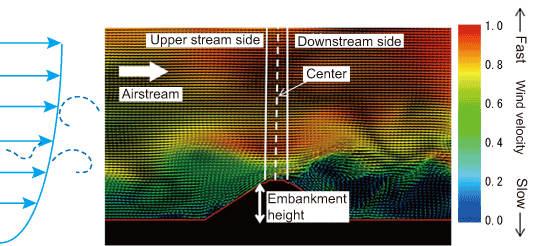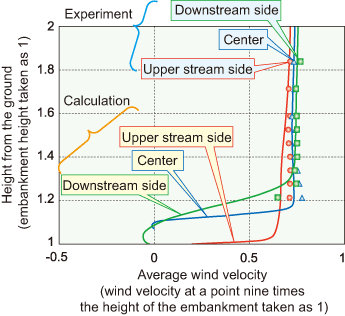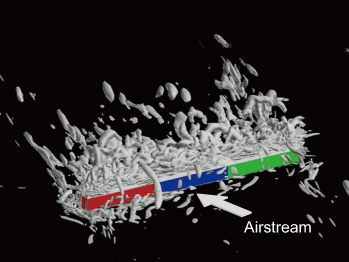2. Numerical simulation of flow around vehicles subjected to cross winds
- The RTRI developed a numerical simulation program that models natural wind and reproduces the flow around structures and vehicles.
In order to realize safe and stable transportation by rail even when exposed to strong wind, it is necessary to ascertain the aerodynamic characteristics of vehicles subjected to cross winds. Until now, most investigations have been carried out using wind tunnel tests. However, numerical simulation is also an effective way of understanding airflow, which is similar to natural wind.
Accordingly, RTRI developed a fluid analysis program capable of simulating natural wind as it approaches embankments and vehicles to form a turbulent boundary layer in the vicinity of the ground. This program enables reproduction of the velocity field of the turbulent boundary layer, which varies temporally and spatially in a complex manner (Fig. 1).
Numerical simulation for flow on an embankment where turbulent boundary layers inflow have shown that wind tunnel test results can be reproduced for average wind velocity distribution (Fig. 2). Further, in order to investigate the characteristics of the wind direction angle of cross winds acting on vehicles, numerical simulation was performed to model the flow around a three-car train set with a simplified shape (Fig. 3). It was thus confirmed that the phenomenon in which diagonal winds increase side forces on the lead vehicle could be qualitatively reproduced.
In future work, RTRI plans to improve the accuracy of the fluid analysis program and utilize it as a tool to provide complementary information for wind tunnel tests.
 Fig. 1 Vector of instantaneous wind velocity near an embankment
Fig. 1 Vector of instantaneous wind velocity near an embankment Fig. 2 Average wind velocity distribution at the embankment
Fig. 2 Average wind velocity distribution at the embankment Fig. 3 Flow around a three-car train set (visualization of vortex structure)
Fig. 3 Flow around a three-car train set (visualization of vortex structure)